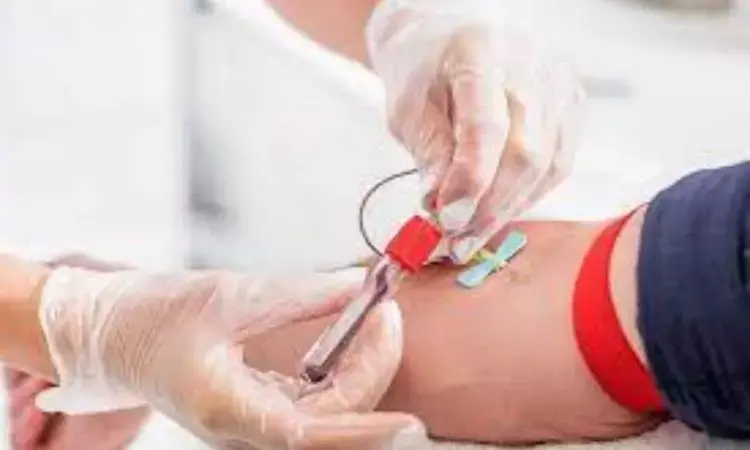- Home
- Medical news & Guidelines
- Anesthesiology
- Cardiology and CTVS
- Critical Care
- Dentistry
- Dermatology
- Diabetes and Endocrinology
- ENT
- Gastroenterology
- Medicine
- Nephrology
- Neurology
- Obstretics-Gynaecology
- Oncology
- Ophthalmology
- Orthopaedics
- Pediatrics-Neonatology
- Psychiatry
- Pulmonology
- Radiology
- Surgery
- Urology
- Laboratory Medicine
- Diet
- Nursing
- Paramedical
- Physiotherapy
- Health news
- Fact Check
- Bone Health Fact Check
- Brain Health Fact Check
- Cancer Related Fact Check
- Child Care Fact Check
- Dental and oral health fact check
- Diabetes and metabolic health fact check
- Diet and Nutrition Fact Check
- Eye and ENT Care Fact Check
- Fitness fact check
- Gut health fact check
- Heart health fact check
- Kidney health fact check
- Medical education fact check
- Men's health fact check
- Respiratory fact check
- Skin and hair care fact check
- Vaccine and Immunization fact check
- Women's health fact check
- AYUSH
- State News
- Andaman and Nicobar Islands
- Andhra Pradesh
- Arunachal Pradesh
- Assam
- Bihar
- Chandigarh
- Chattisgarh
- Dadra and Nagar Haveli
- Daman and Diu
- Delhi
- Goa
- Gujarat
- Haryana
- Himachal Pradesh
- Jammu & Kashmir
- Jharkhand
- Karnataka
- Kerala
- Ladakh
- Lakshadweep
- Madhya Pradesh
- Maharashtra
- Manipur
- Meghalaya
- Mizoram
- Nagaland
- Odisha
- Puducherry
- Punjab
- Rajasthan
- Sikkim
- Tamil Nadu
- Telangana
- Tripura
- Uttar Pradesh
- Uttrakhand
- West Bengal
- Medical Education
- Industry
Continuous measurements of GFR valuable for tracking perioperative changes in renal function

Norway: A recent study has claimed that GFR monitoring over an extended period is feasible and can detect variations in glomerular filtration rate (GFR). The method can be used for tracking perioperative changes in renal function.
The pilot study, published in the International Journal of Nephrology, showed the feasibility of continuous GFR by measurements by continuous iohexol infusion in patients undergoing robot-assisted colorectal cancer surgery.
Previous studies have shown perioperative acute kidney injury (AKI) to be associated with considerable mortality and morbidity. Still, more needs to be done to prevent and treat this condition. This could be due to an inadequate understanding of renal pathology and a need for more tools for continuously monitoring overall kidney function in this setting. The best overall indicator of renal function is the measured GFR (mGFR); creatinine and cystatin C are more often used for GFR monitoring after surgery. Accurate determination of GFR is also critical for drug dosing, particularly for drugs with a narrow therapeutic window.
Iohexol's plasma clearance has been established as a reliable tool for GFR measurement in the steady-state condition. A recent study revealed that a continuous low-dose iohexol infusion could direct GFR changes in ICU patients at high AKI risk. Therefore, Lars M. Ytrebø, UiT – The Arctic University of Norway, Tromsø, Norway, and colleagues aimed to demonstrate that the method can also monitor GFR variations in patients without AKI risk factors undergoing robot-assisted colorectal cancer surgery during the first 72 hrs of the postoperative period.
The study included four patients undergoing robot-assisted colorectal cancer surgery from elective surgery listings. Postoperatively, GFR was determined by the single-sample iohexol clearance method and postoperatively at time intervals by a continuous iohexol infusion for 72 hrs.
Concurrent measurements of plasma concentrations of cystatin C and creatinine were done. GFR was calculated as (iohexol infusion rate (mg/min))/(plasma iohexol concentration (mg/mL)). The association of the three different filtration markers and GFR with time were analyzed. In all four patients, continuous infusion of iohexol was established and maintained throughout the study period without interference with ordinary postoperative care.
The researchers reported the following findings:
- Postoperative GFR at 2 hours were elevated compared to the preoperative measurements for patients 1, 2, and 3 but not for patient 4.
- Patients 1, 2, and 3 had u-shaped postoperative mGFR curves; patient 4 demonstrated a linear increase in mGFR with time.
"Continuous GFR monitoring over an extended period is feasible and can be utilized to investigate postoperative changes in renal function," the authors concluded.
They, however, acknowledged that continuous iohexol infusion is unlikely to become a clinically routine methodology. Still, it may become a valuable tool to evaluate renal function in patients at high risk of acute kidney injury.
Reference:
Kjellbjørn Jakobsen, Bjørn O. Eriksen, Ole M. Fuskevåg, Stephen J. Hodges, Lars M. Ytrebø, "Continuous Infusion of Iohexol to Monitor Perioperative Glomerular Filtration Rate", International Journal of Nephrology, vol. 2022, Article ID 8267829, 6 pages, 2022. https://doi.org/10.1155/2022/8267829
Dr Kamal Kant Kohli-MBBS, DTCD- a chest specialist with more than 30 years of practice and a flair for writing clinical articles, Dr Kamal Kant Kohli joined Medical Dialogues as a Chief Editor of Medical News. Besides writing articles, as an editor, he proofreads and verifies all the medical content published on Medical Dialogues including those coming from journals, studies,medical conferences,guidelines etc. Email: drkohli@medicaldialogues.in. Contact no. 011-43720751


